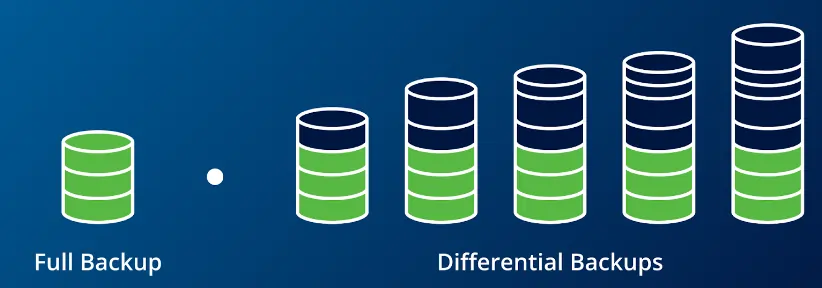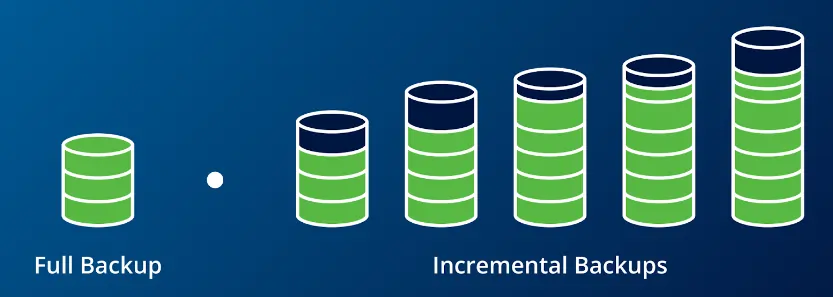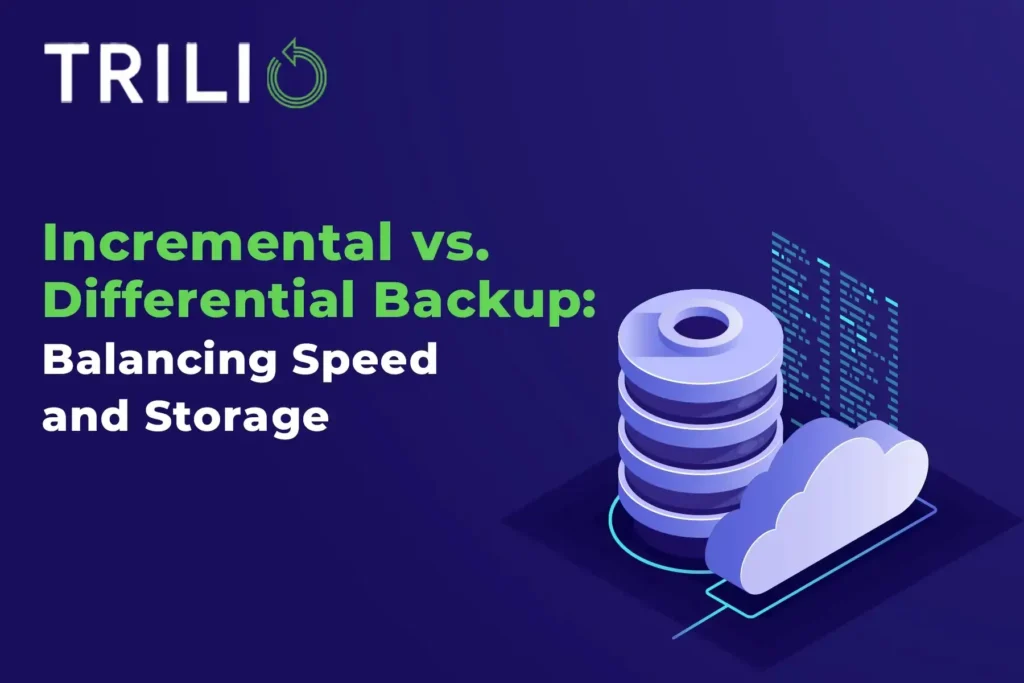Data protection is critical for IT professionals, but choosing between incremental vs. differential backup strategies can be complex. While full backups are key, their limitations in speed, storage, and flexibility become apparent as your data grows. Incremental backups offer a more efficient solution, backing up only the data that has changed since the last backup. This strategy significantly reduces backup time, minimizes storage requirements, and scales well for growing datasets. However, it’s still important to know about the alternatives to pick the best backup type for your business.
In this article, we’ll break down the differences between incremental vs. differential backups, helping you understand the advantages and trade-offs to make an informed choice for your data protection plan.
Backup Basics
Before diving into the specifics of incremental vs. differential backups, let’s define the three backup types:
- Full Backup: Creates a complete copy of all selected data at a given point in time. This serves as a comprehensive snapshot of your system.
- Incremental Backup: Captures only the data that has changed since the last backup (whether that was a full backup or another incremental backup).
- Differential Backup: Captures all data that has changed since the last full backup.
While full backups are a cornerstone of data protection, they can be time-consuming, require significant storage space, and offer less flexibility in choosing a specific point in time for data recovery. Incremental and differential backups provide strategies to address these limitations, leading to faster backups, reduced storage needs, and the ability to pinpoint more recent data for recovery.

Step-by-Step Process of the Differential Backup
- The Base: As with incremental backups, the process begins with a full backup, establishing a baseline. Think of this initial full backup like the first photo of your room – it’s the starting point for tracking changes.
- Capturing Cumulative Changes: Subsequent differential backups identify and record all changes since the initial full backup. This means that each differential backup grows larger over time, potentially leading to storage issues. As more changes accumulate since the last full backup, the difference between an incremental backup and a differential backup becomes significant. Unlike incrementals, which stay consistently small, differential backups require progressively more storage space.
- Restoration Considerations: While differential backups offer faster restores than incrementals, this comes at the cost of increased complexity as time passes. Since each differential backup includes all changes since the initial full backup, you still need that full backup and the most recent differential to restore data. This can increase management overhead compared to incremental backups.
Explanation of Incremental Backups
Incremental backups capture only the data that has changed since the last backup of any type (full or incremental). To be extra efficient, this change-tracking is often done at the file or block level for efficiency.

Step-by-Step Process of the Incremental Backup
- The Base: Everything starts with a full backup, which serves as the comprehensive snapshot of your data (files, applications, configurations, etc.) at a specific point in time. This initial backup is a crucial reference point for all subsequent backups and restorations.
- Change Tracking: To optimize the process, your company’s backup software doesn’t blindly copy everything over and over again. Instead, it intelligently determines what has changed through various methods, such as comparing file creation/modification timestamps to the time of the last backup, calculating unique checksums (“fingerprints”) of files and data blocks to detect changes, or even directly monitoring the file system for real-time change notifications.
Incremental backups are like noting only the changes you make to your room afterward – maybe you moved a chair or added a picture. The backup software cleverly checks what’s different, for example, comparing when files were last changed.
- Recording Changes: Once the changes have been pinpointed, only those specific modifications are included in the incremental backup. This targeted approach significantly reduces the size (and therefore time) required for each incremental backup compared to repeatedly performing a full backup. This focus on changes makes each incremental backup small and fast to create.
- Building a Chain: It’s important to understand that incremental backups are not standalone. To restore data, you need the original full backup and all subsequent incremental backups in the correct sequence. Think of it like a chain: The full backup is the anchor, and each incremental is a link building off the one before, creating a complete picture of your data.
To put your room back to how it was, you need the full photo and all the changes you recorded in the correct order.
Types of Incremental Backups
Regular Incremental Backup
This is the bread-and-butter of incremental vs. differential backup strategies. Think of it like updating a document: only saving the edits you make instead of creating a whole new copy each time. Regular incremental backups record only the files that have changed since the last backup of any kind (full or incremental). If your data doesn’t change drastically on a daily basis, regular incremental backups are a great way to balance speed, storage efficiency, and the flexibility to pinpoint recent recovery points.
Synthetic Full Backup
Imagine having to constantly repaint an entire canvas instead of just touching up the changed areas. That’s the traditional full backup approach. Synthetic full backups offer a workaround. They leverage the initial full backup and subsequent incremental backups, essentially merging them together to produce a new, up-to-date full backup. This avoids the resource drain of repeated full backups, making it a smart choice for organizations dealing with large or rapidly changing datasets. For example, if you work with large video files, synthetic full backups can prevent hours-long backup processes. Companies can use this method to avoid creating traditional full backups and thus minimize the impact on network performance.
Progressive Incremental Backup (Incremental Forever)
This method takes the “changes only” focus to the extreme. After a single full backup, all subsequent backups are incremental, sent directly to storage. The backup system stores each increment and cleverly manages them. When a restore is needed, it generates a full backup on demand using the most recent data. Think of it like a highly organized library where each book represents an incremental backup – even if you only need one chapter, the system can locate it and construct the complete story.
Reverse Incremental Backup
While regular incremental backups create a chain, reverse incremental backups merge each new update back into the original full backup. This ensures that you always have a readily available, up-to-date full backup without the need to apply a series of incrementals. It’s also a safeguard against data corruption, as you can always revert to an earlier full backup if needed. It is like constantly updating a master photo album – each new picture merges into the existing album, always keeping it current.
Block-Level Incremental Backup
For granular efficiency, block-level incremental backups work below the file level. They track changes within individual data blocks. In scenarios with large files that undergo frequent changes (like databases or virtual machine images), block-level incremental backups can offer significant speed and storage optimization compared to incremental vs. differential backup approaches that operate on full files. Instead of focusing on entire documents, think of it as tracking edits at the paragraph level.
The Key Differences: Speed, Storage and More
Storage Space and Costs
Incremental vs. differential backup strategies present very different storage requirements. Incremental backups hold a significant advantage in this area. Since they only record the changes since the previous backup, their size remains relatively small and consistent. This translates to lower storage costs, particularly over long periods of time, making incremental backups a scalable solution for growing datasets.
In contrast, differential backups steadily increase in size as the time since the last full backup grows. Because each differential backup captures all changes since that initial full backup, they encompass modifications made across multiple backup cycles. This results in a need for progressively more storage space, which can lead to higher costs as your data and retention periods increase.
Technical Considerations
The efficiency of the backup software’s change-tracking mechanisms can impact storage usage for both incremental and differential backup strategies.
Compression technologies can be used to reduce the overall storage footprint but might come with a trade-off in backup and restoration times.
Data Restoration
When considering incremental vs. differential backup, restoration speed differs significantly. Differential backups generally offer a faster restore process compared to incremental backups. This is because restoring from a differential backup only requires the initial full backup and the most recent differential backup.
Incremental backups, on the other hand, have a more complex restoration process. Since each incremental backup relies on the previous one, you need the full backup and a chain of incremental backups in the correct order to restore your data. This can be time-consuming, especially if the time since the last full backup is significant.
When to Use Incremental vs. Differential Backup
Choosing the most suitable backup strategy depends on several factors. In this section, we’ll look at two prime considerations: frequency of data changes and business requirements (RTO and RPO).
Frequency of Data Changes
If your data undergoes frequent modifications, incremental backups are often the ideal choice. Their focus on capturing only the changes aligns well with environments where data is constantly updated. This results in benefits for both storage efficiency and backup speed.
Business Requirements and RTO/RPO
Your business continuity plans and disaster recovery objectives play a key role in determining whether incremental vs. differential backup better suits your needs. Let’s focus on two critical metrics:
- Recovery Time Objective (RTO): The maximum allowable time to restore data and systems after an incident. If minimizing downtime is a top priority, differential backups might be more suitable due to their faster restoration process.
- Recovery Point Objective (RPO): The maximum acceptable amount of data loss (measured in time) in case of a disruption. Frequent incremental backups can help achieve a more granular RPO.
Technical Considerations
It’s essential to evaluate the speed of your network and storage infrastructure. If restoring large differential backups could bottleneck your recovery process, incremental backups might be a more practical solution.
Conclusion
Choosing between incremental vs. differential backup requires careful consideration of your organization’s specific data protection needs. There’s no one-size-fits-all answer, and the best strategy depends on a balance of speed, storage, recovery objectives, and budget. While differential backups aren’t necessarily worse, incremental backups have several advantages:
- Storage Savings: Their focus on changes minimizes storage needs, a significant advantage for growing datasets and long-term retention.
- Backup Speed: Incremental backups (daily/weekly/other period) are often significantly faster than full backups, reducing the impact on your network and systems.
- Scalability: Incremental backups effortlessly adapt to increasing amounts of data, making them a future-proof solution.
Schedule a demo with Trilio to learn more about our backup and recovery solutions and how they can protect your IT environment.
FAQs
Can you summarize the main difference between incremental vs. differential backup?
Incremental backups focus on capturing only the changes since the last backup of any type (full or incremental). In contrast, differential backups capture all changes since the last full backup. This means incremental backups are usually smaller, while differential backups offer a bit faster restorations.
Which approach, incremental vs. differential backup, is more cost-effective in the long run?
Incremental backups generally win in terms of the cost because they consistently capture only the changes, their storage footprint remains smaller over time, leading to lower storage costs.
My data changes constantly. Should I choose an incremental or differential backup strategy?
In environments with frequent data changes, incremental backups often excel. Their granular, change-focused approach aligns well with the constant updates, maximizing efficiency.
What is an "incremental forever" backup strategy?
ncremental forever means taking an initial full backup and then relying exclusively on incremental backups from that point onwards. Specialized backup software is needed as it manages restoring data by piecing together the incremental backups behind the scenes. This minimizes storage needs, but carries an increased risk of data loss if any incremental backup in the chain becomes corrupted.
If I need help choosing the right backup strategy, are there resources available?
Trilio offers consultations and demos to help you determine the best approach for your specific needs. Our experts can guide you towards a solution that aligns with your requirements for data protection, recovery speed, and budget.

